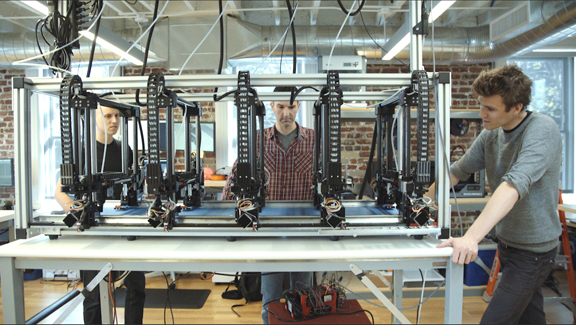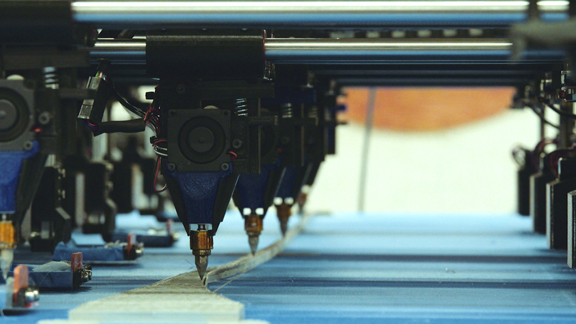Autodesk Project Escher Aims to Speed Up Additive Manufacturing with Multiple Nozzles

The multiple-nozzle printing system proposed by Autodesk with its Project Escher (image courtesy of Autodesk).
Latest News
March 24, 2016
 The multiple-nozzle printing system proposed by Autodesk with its Project Escher (image courtesy of Autodesk).
The multiple-nozzle printing system proposed by Autodesk with its Project Escher (image courtesy of Autodesk).If it takes six hours for one person to do a job, why not assign six persons to the same job to finish it in an hour? The principle is as applicable to computation as it is to manual labor.
On March 3, in the Autodesk Pier 9 workshop overlooking the San Francisco Bay, the company's hardware lead Cory Bloome unveiled Project Escher, described as “a parallel processing system where numerous independent extruders collaborate to make one thing, enabling faster print speeds at a large scale without compromising print detail (”New Advancements in 3D Printing to Improve Speed and Scale,” Autodesk, March 4).
The strategy is to deploy multiple nozzles to speed up the typical fused deposition modeling (FDM) process. It's simple in principle, but not so in implementation. The noddles—or the print heads—have to travel in crisscrossing paths to execute a single print job, risking collision and wire tangling. Furthermore, the software has to subdivide the 3D model and assign the appropriate portions to be printed at the right time by the nozzles.
Bloome explained, the software “takes an object, divides the geometry into parts that several printers can independently print, and optimizes the job so each printer can print most efficiently.”
“When you have only one nozzle to produce an object, it takes an extremely long time to produce an object of industrial scale,” said Andreas Bastian, Autodesk's 3D printing research scientist. “What makes [Escher] special is its ability to use a number of tools to describe that geometry in parallel ... [That] dramatically reduces the amount of time in fabrication.”
Bloome said, “Currently, no manufacturers make these systems. Traditionally, you build a machine, then develop the software to drive the machine. Here, the hardware has to be configured to the software—not the other way around.”
But that doesn't mean Escher is a piece of software with no appropriate hardware to run on. Bloome explained “The printing system is essentially a three-axis gantry system. People have been using it for 30-40 years.”
Autodesk's current printer, Ember, uses stereolithography to build parts. The hardware is open source, which means Ember's specs and architecture are freely available. The size and scale of Ember makes the printer more suitable for building smaller, portable parts. By contrast, the Escher approach could be a solution to manufacture larger parts (for example, building components).
At the Pier 9 event, Autodesk executives made it abundantly clear the company isn't developing another printer as part of Project Escher. It leaves the door open for the company's hardware partners and AM vendors to develop an Escher-powered printer.
For more, watch the video demonstration from Autodesk below:
Subscribe to our FREE magazine, FREE email newsletters or both!
Latest News
About the Author
Kenneth Wong is Digital Engineering’s resident blogger and senior editor. Email him at [email protected] or share your thoughts on this article at digitaleng.news/facebook.
Follow DE






